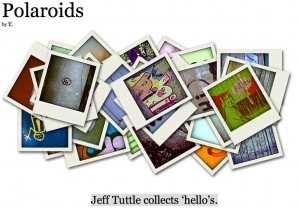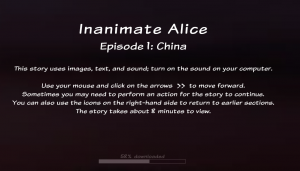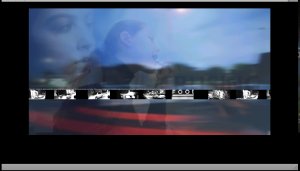Video + Interaction
On whether video games are the new media of choice for delivering stories in our digital age.
Are all video games stories? No. Tetris.
But the vast majority of games at the very least have a back story. That is, there’s some story that precedes the interactive game the player partakes in. Even Space Invaders as Jesper Juul points out, has a back story. He writes, “A prehistory is suggested in [Space] Invaders: An invasion presupposes a situation before the invasion. It is clear from the science fiction we know that these aliens are evil and should be chased away. So the title suggests a simple structure with a positive state broken by an external evil force.” Just to emphasize: a story is suggested by Space Invaders, but not actually stated.
Following Space Invaders, though, there were plenty of games that did state the story that preceded play. Classic arcade games like Double Dragon, Alien Syndrome, and Paperboy usually had some minimal introductory scenario that got the story rolling (click the titles to see the intros). The typical one had some evil mastermind kidnapping your girlfriend. Wasn’t that the premise of most of the Super Mario games? Princess Peach is kidnapped and we’re off.
In a lot of these “back story” games, though, the play doesn’t move the story forward much. The initial computer animated sequence provides a context for gameplay, but what follows is a series of challenges that have little to do with plot.
This situation continues nowadays with online shooters, which dispense with story altogether. Even the ever-popular Halo series, which has a definite narrative thread, throws story out the window for its online play, where a player is usually on a team of marines fighting against another team of marines. Such a scenario actually runs counter to the Halo story, where the player never fights against his own species.
Speaking of the Halo story, though, in it we can see a more sophisticated method of conveying the narrative. It doesn’t just begin with back story. It then proceeds to fill in gaps between the various “levels” or chapters using “cut scenes.” The cut scenes exist to propel the story forward and they alternate with actual gameplay.
But it’s rare (and a fairly recent phenomenon) that gameplay and narrative are actually delivered at the same time. RPGs and action-adventure games sometimes attempt to offer the player various narrative choices, but often those choices take place in interactive cut scenes rather than in the gameplay itself. One of my favorite examples of such an approach comes from the game Deus Ex: Invisible War. Are there any games that don’t pause the gameplay to allow the player to move the story forward through interaction? Prior to reading Jesper Juul, I would have said yes, definitely.
But now I’m not so sure.
He makes the claim that you “cannot have interactivity and narration at the same time,” an argument he bases on a pretty complex discussion of story time, narrative time, and reading time. But I think I have a simpler explanation.
If you’ve ever played a game with a narrative component to it, think about whether the narrative thread of the game would have been different without any of the player’s game challenges like fighting, puzzle solving, platform jumping, etc. In most cases, I think, it’s an either/or situation. Either you’re fighting baddies, collecting coins, doing whatever you’re character is supposed to be doing OR you’re watching the story progress through cut scenes and/or through choosing pre-packaged lines of dialogue for your character to deliver. Thus, with every video game I can think of, if you were to fast forward through the gameplay sections, the story would remain completely intact.
Modern games are getting more fluid with this alternating narration/gameplay format (a game like Fallout 3 being a good example of that — see the fifth video here for an example), but that’s all they’re doing — they’re alternating better. They’re not actually making the narrative as interactive as many game developers claim they are. Pretty hefty claims, if you ask me. “A growing number [of developers],” according to the “Brainy Gamer,” now believe that “the designer builds a system, but the player authors the story.”
Except they’re wrong. The player cannot co-author the story. As Jonathan Blow notes, “Story is a filtered presentation of events that already happened.” The player’s interaction with a game consists of alternating between navigating the pre-written (sometimes choose-your-own-adventure) story and the challenging situations that don’t really matter to the narrative. There’s no authorship on the player’s part.
Steve Gaynor articulates this sentiment well: “Video games are not a traditional storytelling medium per se. The player is an agent of chaos, making the medium ill-equipped to convey a pre-authored narrative with anywhere near the effectiveness of books or film. Rather, a video game is a box of possibilities, and the best stories told are those that arise from the player expressing his own agency within a functional, believable gameworld. These are player stories, not author stories, and hence they belong to the player himself.”
What I think Gaynor means is that there are stories delivered by the video game and stories that arise from the video game. Stories delivered by the game are in no way co-authored by the player, and stories that arise from the player’s experience — from the “box of possibilities” — are, I would argue, experiences, not stories. Sure, when you tell someone about what happened in a game, it’s now a story, but in the game itself, it’s an experience.
Gaynor continues: “Unlike a great film or piece of literature, (video games) don’t give the audience an admiration for the genius in someone else’s work; they instead supply the potential for genuine personal experience, acts attempted and accomplished by the player as an individual, unique memories that are the player’s to own and to pass on.”
The goal of many developers, then, is to provide a rich world that the player can navigate freely; these worlds are often referred to as “sandboxes.” But the purest sandboxes eradicate narrative.
Enter Second Life, the perfect example of a virtual experience that has no narrative element to it. Sure, some stories may arise out of it, but Second Life itself has no more plot than the state of Wisconsin does.
In a figurative sense, sure, we’re all authoring our own life story, but that’s just a metaphor. We’re experiencing our lives. My life isn’t a story until I craft it into a “filtered presentation of events that already happened.” Thus, narrative and experience are somewhat at odds. The listener/reader/viewer/player cannot tell the story she’s receiving. It’s an impossibility by definition. She can choose between various options if the storyteller gives her any, but to say she’s then co-authoring the story is hyperbole.
As for video games, they use story to create an enjoyable context for gameplay. And they are undoubtedly an effective delivery medium for some pretty good stories. But the player’s interactivity isn’t as revolutionary as some would make it out to be. They do raise some interesting questions, however: what is the storyteller’s goal for his audience and what is the ideal reception on the part of the receiver of the story? I’ll explore those topics next.




